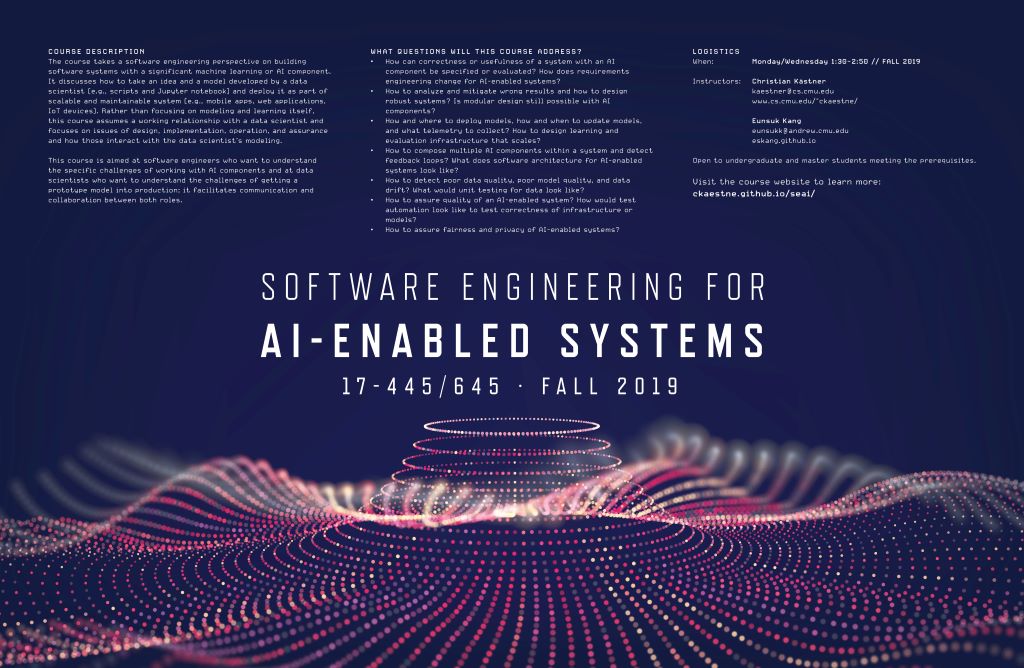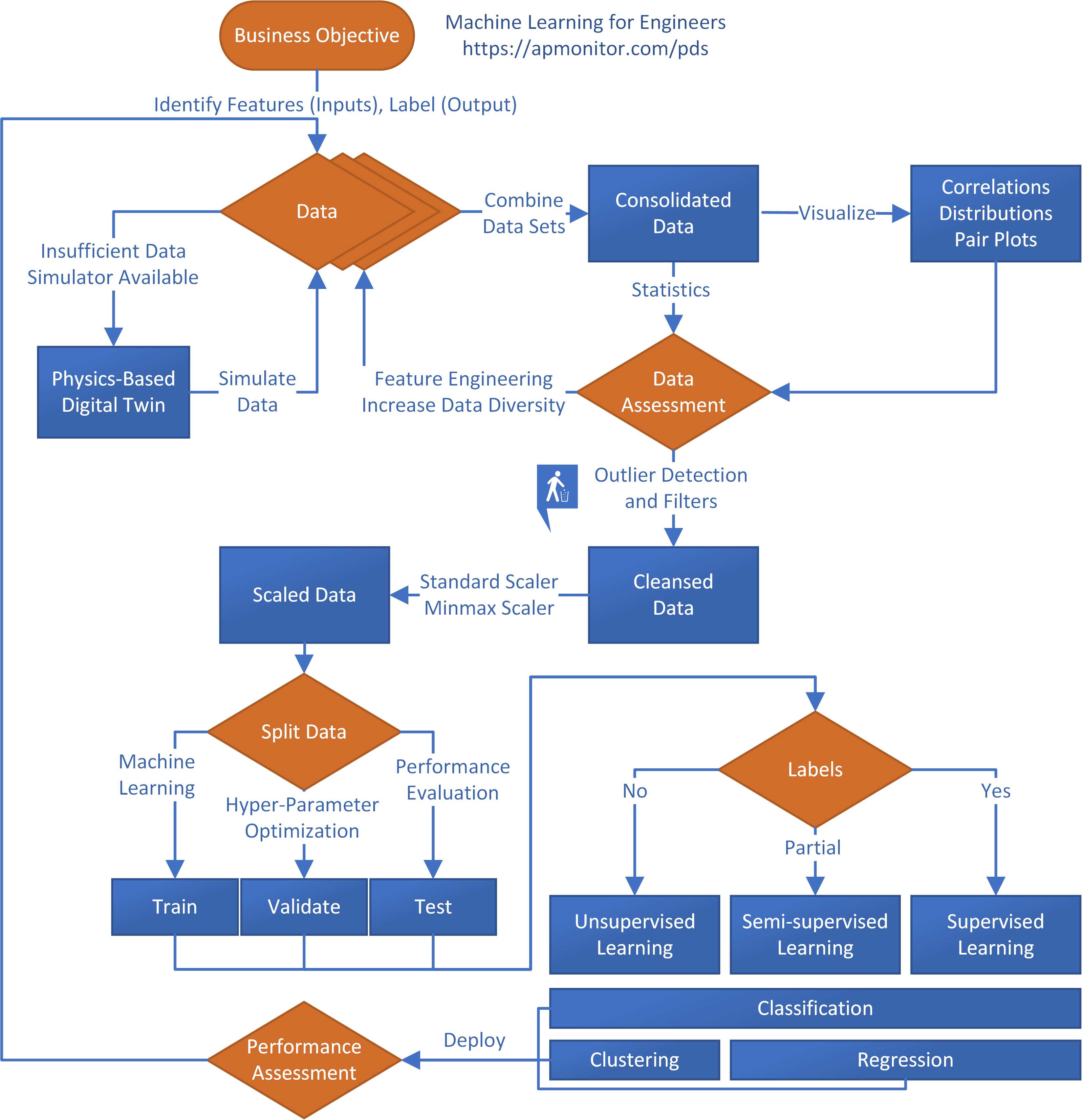All Categories
Featured
Table of Contents
- – Rumored Buzz on How To Become A Machine Learni...
- – The 3-Minute Rule for Software Engineering For...
- – The Ultimate Guide To How To Become A Machine...
- – A Biased View of How To Become A Machine Lear...
- – The Best Guide To Best Machine Learning Cour...
- – Some Of What Do Machine Learning Engineers A...
You most likely understand Santiago from his Twitter. On Twitter, daily, he shares a whole lot of functional things concerning maker discovering. Many thanks, Santiago, for joining us today. Welcome. (2:39) Santiago: Thanks for inviting me. (3:16) Alexey: Before we go into our main subject of moving from software engineering to artificial intelligence, perhaps we can begin with your background.
I went to college, got a computer science degree, and I started constructing software program. Back after that, I had no idea regarding device learning.
I recognize you have actually been using the term "transitioning from software design to artificial intelligence". I such as the term "contributing to my ability set the artificial intelligence abilities" extra due to the fact that I assume if you're a software program engineer, you are currently providing a lot of worth. By including machine learning now, you're boosting the influence that you can have on the sector.
Alexey: This comes back to one of your tweets or perhaps it was from your training course when you compare two methods to understanding. In this situation, it was some problem from Kaggle regarding this Titanic dataset, and you just learn exactly how to resolve this problem utilizing a details device, like decision trees from SciKit Learn.
Rumored Buzz on How To Become A Machine Learning Engineer - Uc Riverside
You first learn math, or direct algebra, calculus. When you know the mathematics, you go to machine discovering theory and you discover the theory.
If I have an electric outlet here that I require replacing, I do not intend to most likely to college, invest 4 years comprehending the math behind electricity and the physics and all of that, just to alter an electrical outlet. I prefer to start with the outlet and find a YouTube video clip that assists me undergo the trouble.
Santiago: I really like the concept of beginning with a trouble, attempting to toss out what I recognize up to that problem and understand why it does not work. Get hold of the tools that I need to resolve that issue and start digging much deeper and deeper and deeper from that factor on.
Alexey: Maybe we can talk a little bit regarding discovering sources. You pointed out in Kaggle there is an intro tutorial, where you can obtain and discover how to make choice trees.
The only demand for that training course is that you know a little of Python. If you're a developer, that's a fantastic base. (38:48) Santiago: If you're not a designer, after that I do have a pin on my Twitter account. If you most likely to my profile, the tweet that's going to get on the top, the one that says "pinned tweet".
The 3-Minute Rule for Software Engineering For Ai-enabled Systems (Se4ai)

Even if you're not a designer, you can start with Python and work your way to more artificial intelligence. This roadmap is concentrated on Coursera, which is a platform that I actually, really like. You can audit every one of the programs absolutely free or you can pay for the Coursera subscription to obtain certifications if you wish to.
Alexey: This comes back to one of your tweets or possibly it was from your course when you contrast 2 methods to learning. In this case, it was some problem from Kaggle concerning this Titanic dataset, and you just find out just how to solve this problem utilizing a specific tool, like decision trees from SciKit Learn.

You first discover mathematics, or linear algebra, calculus. When you recognize the math, you go to device learning concept and you discover the theory. Four years later on, you ultimately come to applications, "Okay, just how do I utilize all these 4 years of math to fix this Titanic trouble?" Right? In the former, you kind of save yourself some time, I assume.
If I have an electrical outlet right here that I need changing, I do not wish to go to university, invest four years comprehending the math behind electricity and the physics and all of that, just to transform an electrical outlet. I would rather begin with the outlet and locate a YouTube video clip that helps me undergo the issue.
Poor example. But you understand, right? (27:22) Santiago: I really like the idea of starting with a trouble, attempting to toss out what I recognize approximately that issue and understand why it does not work. Get the tools that I need to address that issue and start digging deeper and much deeper and deeper from that factor on.
Alexey: Possibly we can chat a bit about finding out resources. You discussed in Kaggle there is an introduction tutorial, where you can get and find out how to make choice trees.
The Ultimate Guide To How To Become A Machine Learning Engineer (With Skills)
The only demand for that course is that you understand a little bit of Python. If you're a programmer, that's a fantastic starting point. (38:48) Santiago: If you're not a programmer, after that I do have a pin on my Twitter account. If you go to my profile, the tweet that's mosting likely to get on the top, the one that says "pinned tweet".
Even if you're not a designer, you can begin with Python and work your method to more artificial intelligence. This roadmap is focused on Coursera, which is a system that I really, truly like. You can investigate every one of the courses completely free or you can pay for the Coursera subscription to get certifications if you wish to.
A Biased View of How To Become A Machine Learning Engineer
To ensure that's what I would do. Alexey: This returns to among your tweets or perhaps it was from your program when you contrast 2 techniques to discovering. One approach is the problem based strategy, which you simply chatted around. You discover an issue. In this instance, it was some problem from Kaggle regarding this Titanic dataset, and you simply find out how to fix this trouble utilizing a certain tool, like choice trees from SciKit Learn.

You first discover mathematics, or linear algebra, calculus. When you understand the mathematics, you go to maker understanding theory and you find out the theory.
If I have an electrical outlet below that I require changing, I don't want to most likely to college, invest 4 years comprehending the math behind electrical power and the physics and all of that, just to transform an electrical outlet. I prefer to start with the outlet and discover a YouTube video clip that assists me experience the trouble.
Negative analogy. But you understand, right? (27:22) Santiago: I actually like the idea of beginning with an issue, trying to throw out what I understand up to that problem and recognize why it doesn't work. Then grab the devices that I require to resolve that issue and start digging deeper and much deeper and deeper from that factor on.
Alexey: Possibly we can speak a bit concerning finding out resources. You mentioned in Kaggle there is an intro tutorial, where you can obtain and discover how to make decision trees.
The Best Guide To Best Machine Learning Courses & Certificates [2025]
The only demand for that program is that you know a little bit of Python. If you go to my account, the tweet that's going to be on the top, the one that says "pinned tweet".
Even if you're not a developer, you can start with Python and work your method to more machine discovering. This roadmap is concentrated on Coursera, which is a system that I truly, really like. You can examine every one of the training courses completely free or you can spend for the Coursera registration to get certificates if you intend to.
That's what I would certainly do. Alexey: This returns to among your tweets or perhaps it was from your training course when you contrast 2 methods to knowing. One strategy is the issue based technique, which you simply spoke about. You locate a trouble. In this instance, it was some trouble from Kaggle about this Titanic dataset, and you just find out how to resolve this issue using a particular tool, like choice trees from SciKit Learn.
You first learn math, or direct algebra, calculus. When you know the mathematics, you go to device knowing theory and you discover the theory.
Some Of What Do Machine Learning Engineers Actually Do?
If I have an electric outlet right here that I need replacing, I do not wish to most likely to college, invest four years recognizing the mathematics behind electricity and the physics and all of that, simply to transform an electrical outlet. I prefer to begin with the outlet and find a YouTube video clip that helps me experience the issue.
Bad analogy. You get the concept? (27:22) Santiago: I actually like the concept of beginning with an issue, attempting to toss out what I know approximately that trouble and recognize why it does not work. Get the tools that I require to address that issue and begin digging much deeper and much deeper and much deeper from that factor on.

Alexey: Possibly we can speak a little bit concerning finding out resources. You pointed out in Kaggle there is an intro tutorial, where you can get and discover exactly how to make decision trees.
The only demand for that program is that you recognize a little bit of Python. If you're a developer, that's a wonderful beginning point. (38:48) Santiago: If you're not a programmer, then I do have a pin on my Twitter account. If you most likely to my profile, the tweet that's going to get on the top, the one that states "pinned tweet".
Also if you're not a programmer, you can begin with Python and work your method to more artificial intelligence. This roadmap is concentrated on Coursera, which is a platform that I truly, really like. You can investigate every one of the programs free of charge or you can pay for the Coursera membership to obtain certificates if you wish to.
Table of Contents
- – Rumored Buzz on How To Become A Machine Learni...
- – The 3-Minute Rule for Software Engineering For...
- – The Ultimate Guide To How To Become A Machine...
- – A Biased View of How To Become A Machine Lear...
- – The Best Guide To Best Machine Learning Cour...
- – Some Of What Do Machine Learning Engineers A...
Latest Posts
Tech Interview Handbook: A Technical Interview Guide For Busy Engineers
The Best Open-source Resources For Data Engineering Interview Preparation
Front-end Vs. Back-end Interviews – Key Differences You Need To Know
More
Latest Posts
Tech Interview Handbook: A Technical Interview Guide For Busy Engineers
The Best Open-source Resources For Data Engineering Interview Preparation
Front-end Vs. Back-end Interviews – Key Differences You Need To Know